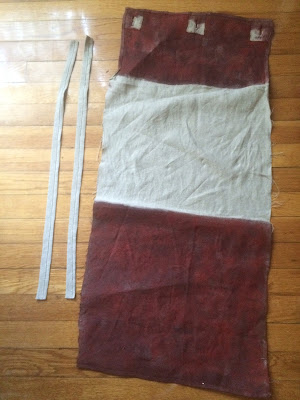 |
| Militia knapsack on a Virginia Militiaman in 1781. The extant pack is actually of Penna or New England origin...ah well. |
This is my second attempt at this knapsack and I finally got the paint consistency correct. The previous examples I constructed used pure modern oil paints, which are not the same consistency as 18th c oil paint and have enamel hardeners, apparently. Out of the gate, my original packs were too stiff and eventually the paint cracked after a few years of use (which is a shame as they were made from vintage Irish linen canvas from Royal Navy hammock mattress covers).
 |
| Ready for assembly. I used a heavy weight natural linen. Acceptable for a pack, but too light for a tent. |
 |
| Sewn inside out and turned. As I begin making these for sale, I will use two needles and a saddle stitch as it will make the seam stronger. |
For the construction, I used hemp cord to sew the body (with a backstitch) and affix the straps (whipstitch). I would recommend a saddle stitch in the future.
 |
| Close up of the backstitch. I would finish off the corner by backing up the stitch for two inches. I did the same at the opening of the bag as these two areas would see the most stress. |
 |
| Placement of shoulder strap. I used a whipstitch to close the seam as one would when recreating the Uhl Knapsack. |
The button holes and top stitching were completed with Burnley and Trowbridge's heaviest weight linen thread. The pack was comfortable and I wore it for several hours during the reenactments of the Green Spring and Guilford Courthouse fights last week. One would think that the small straps (5/8 in) would cut into the shoulders, but as it is small, it doesn't hold so much that it is uncomfortable. but the only addition I would make is tying a sternum strap across the front to keep the pack centered on the back. If you carry a blanket, I would tie it with thongs to the straps at the top of the pack.
 |
| The completed knapsack |
For more on period knapsack construction, I highly recommend the collections at Old Sturbridge Village, which are a bit after our time, but still relevant, files and notes on the Rev War Reenactors Facebook Page, and the article, "Cost of a Knapsack, Complete" by the incomparable John U. Rees.














